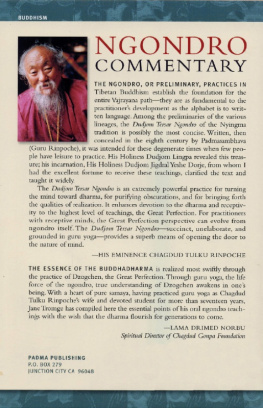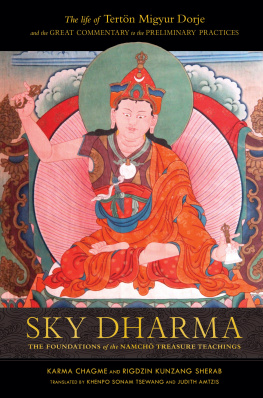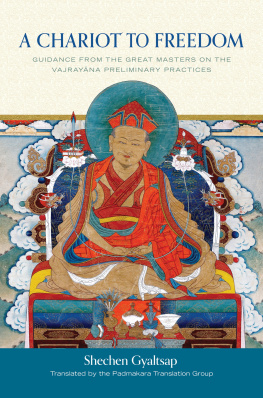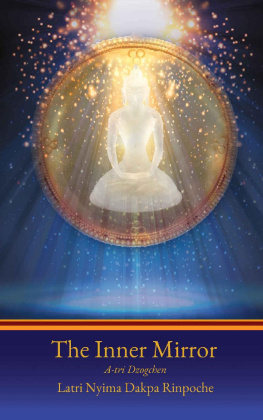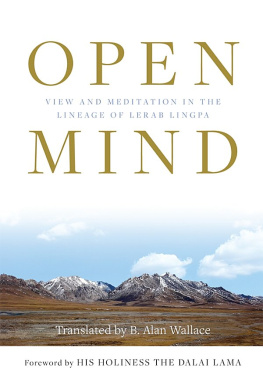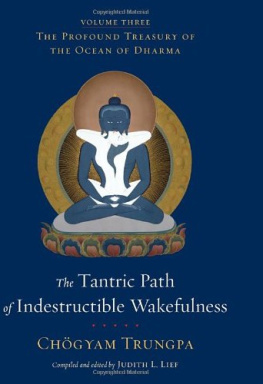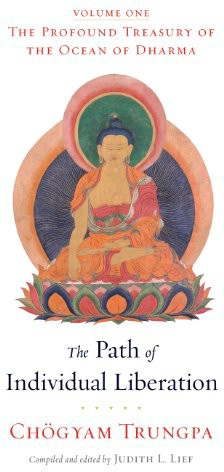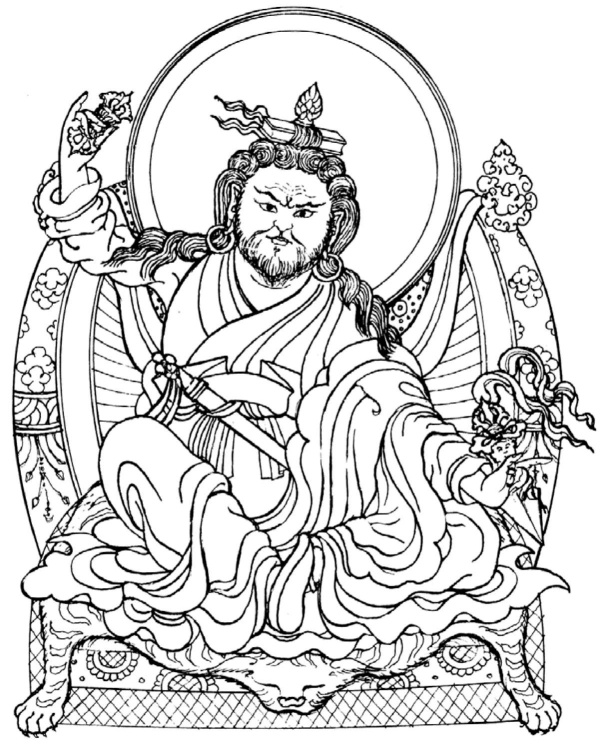Published by Padma Publishing
P.O. Box 279
Junction City, CA 96048-0279
www.tibetantreasures.com
Padma Publishing 1995
All rights reserved. No part of this book may be reproduced in any form or by any means, electronic or mechanical, including photocopy, recording or any information storage or retrieval system, without permission in writing from the publisher.
Printed in the United States of America
Second Printing 2003
Third Printing 2011
eBook 2015
Library of Congress Cataloging-in-Publication Data
Tromge, Jane
Ngondro commentary: Instructions for the concise preliminary
practices of the New Treasure of Dudjom / compiled from the teachings of His Eminence Chagdud Tulku by Jane Tromge (Chagdud Khadro)
p. cm.
1. Nyingmapa (Sect)Rituals. 2. Spiritual lifeNyingmapa (Sect)
I. Chagdud Tulku, 1930-. II. Title
BQ7662.6.T73 1995
294.3 438dc20
95-18666
CIP
ISBN 1-881847-06-3
ISBN 978-1-881847-06-9 (Softcover)
ISBN: 978-1-881847-49-6 (eBook)
Contents
His Holiness Garwang Dudjom Lingpa
Preface
IT HAS BEEN MY VERY GREAT PRIVILEGE to compile these ngondro instructions from a wealth of oral teachings offered by His Eminence Chagdud Tulku Rinpoche. Since coming to the United States in 1979, Rinpoche has given these teachings repeatedly, each time with a wonderful warmth of verbal style and each time highlighting different points. In this commentary, the qualities of his spoken words and some of the rich elaboration he provides have yielded to brevity. The goal has been to make extensive information clear and accessible, offering a convenient reference book for practitioners. This, of course, is not meant as a substitute for a direct oral explanation from Chagdud Rinpoche or some other qualified teacher. Rather, I hope the teachings compiled in this volume will instill confidence in those who undertake the Dudjom Tersar Ngondro and support their accomplishment of the full commitment of these preliminary practices.
Even a small book such as this one has required the dedicated effort of many people, beginning with Chagdud Rinpoche himself, who has consistently stressed the importance of completing ngondro as the foundation of Tibetan Vajrayana Buddhist practice. His teachings flow from his own completion of ngondro practices, from extensive knowledge of commentaries on the subject, from carefully retained oral teachings on the Tersar Ngondro received from His Holiness Dudjom Jigdral Yeshe Dorje, and from his profound meditative realization.
Rinpoche made numerous corrections and extensive editorial suggestions while reviewing the manuscript of this book. Although its style falls somewhere between his engaging verbal presentation and the strict conventions of a classical commentary as he would write it, I believe that its contents have not drifted too far from his intention to offer these precious teachings to Western students in straightforward English. I feel a heavy burden of responsibility for any mistakes, omissions, or lack of clarity in the text, for which I apologize in advance.
In addition to the profound debt of gratitude I owe to Chagdud Rinpoche for entrusting me with this project and supporting its completion, I wish to thank translators Tsering Everest and Richard Barron; transcriptionists Joan Szoboky and Angie Ponder; and the editing and production team at Padma Publishing: Mary Racine, Kimberley Snow, Barry Spacks, and Linda Baer. I am also deeply appreciative of others who read the manuscript and made suggestions, and of my sangha friends at Rigdzin Ling who carried my share of tasks so I would have time to write.
Anything written as a ngondro commentary must present itself most humbly, given the existencethough not yet in Englishof the superb ngondro commentaries by His Holiness Dudjom Rinpoche and other Tibetan masters, and the recent availability of the beloved commentary by Patrul Rinpoche, the Kunzang Lama'i Shelung (Words of My Perfect Teacher), in two English translations. Chagdud Rinpoche himself suggested that another commentary was unnecessary. Still, many who find special pleasure and inspiration in his teachings have often requested a book such as this one. May this brief commentary strengthen understanding and meditative experience and support the accomplishment of ngondro. May it serve as a step toward ultimate compassion and enlightenment.
Foreword
His Eminence Chagdud Tulku
ALL TRADITIONS OF TIBETAN VAJRAYANA BUDDHISM have ngondro practices, but among these the Dudjom Tersar Ngondro of the Nyingma tradition is probably the most concise in terms of recitations and sadhana practice. Hidden in the eighth century by Padmasambhava (Guru Rinpoche), it was intended for these degenerate times when few people have leisure to practice. His Holiness Garwang Dudjom Lingpa (18351904) revealed this treasure; his incarnation, His Holiness Dudjom Jigdral Yeshe Dorje (19041987), clarified the text and taught it widely.
The history of the successive incarnations of Dudjom Lingpa represents an extraordinary demonstration of spiritual potential. He first appeared on this earth, many centuries ago, as the lord among yogins known as Ndan Dorje, who prayed with enormous aspiration to benefit beings. Specifically he prayed, Until the succession of one thousand buddhas of the fortunate aeon has come to an end, may my emanations appear without interruption, accomplishing vast benefit for beings to be tamed! Accordingly, he appeared as Shariputra, one of the Buddha Shakyamuni's foremost disciples; as the prodigy translator Drogban Khye'uchung Lotsawa; and as Dampa Desheg, who founded the great Kat'hog Monastery in Eastern Tibet.
His incarnation as Dudjom Lingpa manifested in response to the explicit command of Guru Rinpoche, who exhorted an emanation to appear as his direct emissary in order to protect beings in these times of spiritual degeneration. He was conceived amid wondrous signs, and at his birth in a small felt tent, the environment was filled with rainbows and delightful fragrances, and a rain of blossoms fell.
Embodiment in nirmanakaya form did not hinder his complete realization of the three kayas, and through his pure vision he had access to the wisdom of the enlightened ones in other realms. Many of his visionary experiences are richly recorded in Buddhahood Without Meditation (Nang-jang). He also revealed twenty-two volumes of teachings and practices, treasures (terma) that had been hidden by Guru Rinpoche and his consort Yeshe Tsogyal so that fresh, uncorrupted dharma transmissions would be available to future practitioners.
The practices Dudjom Lingpa offered were so replete with dharma potential, and the faith of his disciples so strong, that thirteen of the disciples attained rainbow body. At the end of his life, Dudjom Lingpa instructed his students to go to the Padma Kod region of southeastern Tibet. They set out, and one month later heard that their revered teacher had passed from this realm. Having no reason to hurry, they continued their pilgrimage for several years. At last they arrived at a house in Padma Kod. A toddler ran out, welcomed them by name, and invited them inside to enjoy a meal he had instructed his mother to prepare the day before for special guests. The little boy proved to be the incarnation of Dudjom Lingpa.

